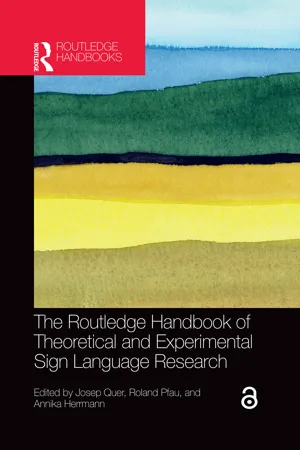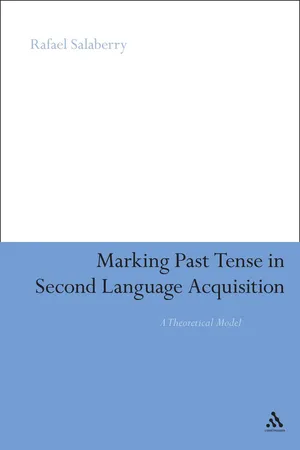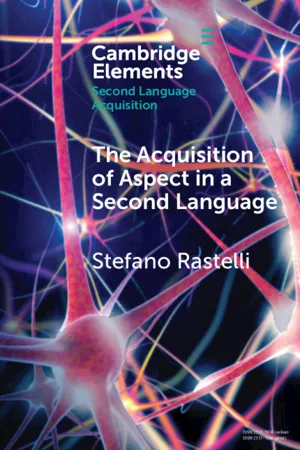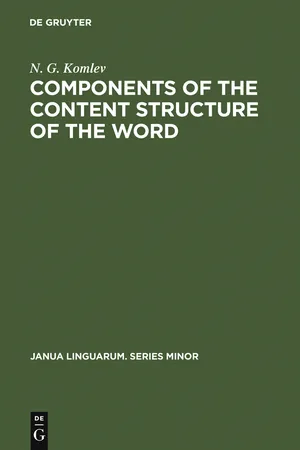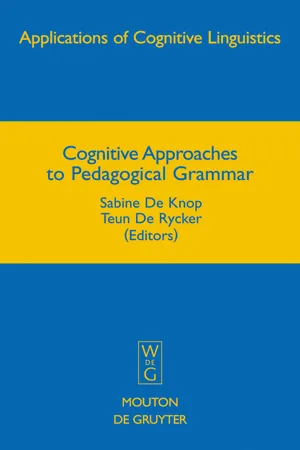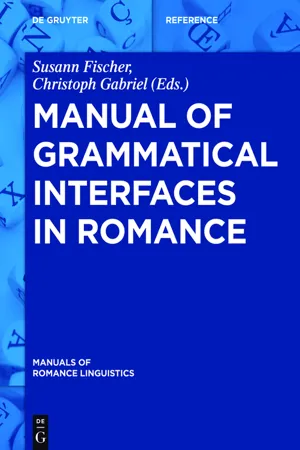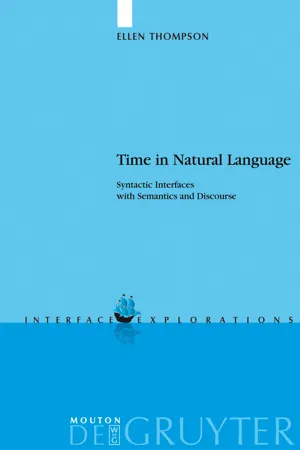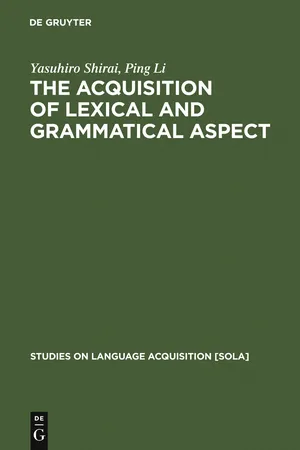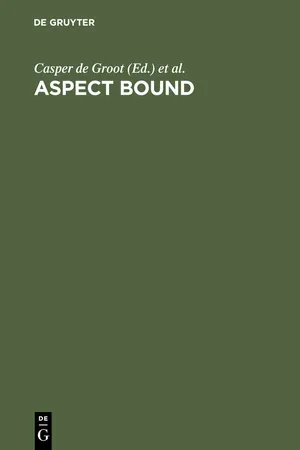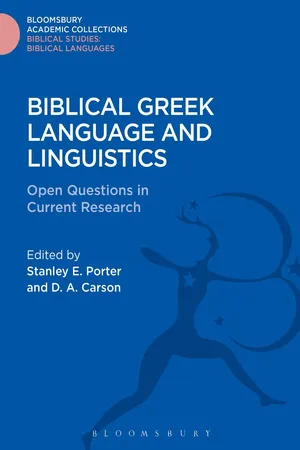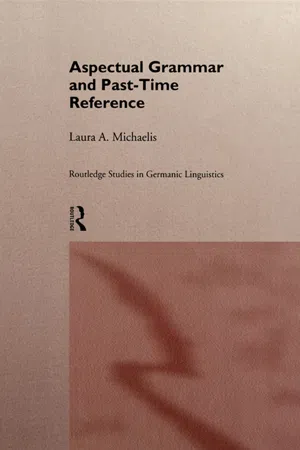Languages & Linguistics
Aspects
Aspects in linguistics refer to different perspectives or dimensions of language that can be analyzed and studied. These may include phonological aspects (sounds), syntactic aspects (sentence structure), semantic aspects (meaning), and pragmatic aspects (language use in context). Understanding these aspects helps linguists and language learners comprehend the complexities of language and communication.
Written by Perlego with AI-assistance
Related key terms
1 of 5
11 Key excerpts on "Aspects"
- Josep Quer, Roland Pfau, Annika Herrmann(Authors)
- 2021(Publication Date)
- Routledge(Publisher)
9Aspect
Theoretical and experimental perspectives
Evie A. Malaia & Marina Milković9.1 Theoretical foundations of aspect
The variety of the world’s languages, including sign languages, has resulted in the need for multiple ways to describe the temporal structure of sentences: tense and aspect. Tense is the easier one to understand: it describes the temporal location of an eventuality in relation to some other point in time (often, another eventuality, which might both be referenced in one sentence). Aspect, on the other hand, refers to the way in which the eventuality itself unfolds in time – how long it takes, whether it is dynamic or static, etc. – from the point of view of the speaker. Linguistic means to encode aspect can vary across languages – the same abstract concept might be denoted by grammatical means in one language, and lexical in another; sign languages use both manual and non-manual means to express aspect. This chapter is concerned with a variety of means of encoding aspect across sign languages, and the ways to precisely express aspectual meaning in relation to the verb’s event structure using spatial means. We will start with lexical aspect – i.e., temporal properties of an event that are implied as part of the verb’s lexical entry. We will then consider systems for denoting grammatical aspect in the languages where these exist, and the relationships between event structure and potential means of aspectual modification, as revealed by empirical research across a variety of sign languages.9.1.1 Lexical aspect (Aktionsart /event structure)
Lexical aspect (also known as Aktionsart, or event structure) describes inherent temporal properties of an eventuality denoted by the verb. Several systems of describing these temporal properties exist. For example, Vendler (1969) identified four types of lexical aspect according to an event’s durativity (necessary occurrence over a period of time), and presence of identifiable temporal reference (start- or end-state). The verbs containing a temporal reference to change of state (inchoative verbs) were subdivided into accomplishments (those which included a durative component, e.g., develop ) and achievements (verbs of instantaneous change, e.g., break ). Verbs without a temporal reference were subdivided into durative actions (e.g., walk ) and states (e.g., know ), which do not require duration. Analyses of event structure also often include semelfactives (punctual events that often occur in sets of multiples, e.g., knock or blink ); for conflicting analyses, see Smith (1997) and Rothstein (2004). The structure of an inchoative event, as introduced above, is typically assumed to have a temporal reference to the time of change (onset, an end-point, or a punctual change). The events that do have such a time-point as part of their semantics are termed telic (from Greek telos ‘goal’); those that do not are called atelic- eBook - PDF
Marking Past Tense in Second Language Acquisition
A Theoretical Model
- Rafael Salaberry(Author)
- 2008(Publication Date)
- Continuum(Publisher)
Chapter 2 Delimiting Lexical and Grammatical Aspect 1. Introduction Despite the apparent plethora of publications addressing aspect (both in terms of theoretical descriptions and acquisitional processes), Binnick (1991: 213) contends that 'no complete aspectual description of any lan-guage exists. Nor does current aspectological theory provide an adequate theoretical base for such description'. In turn, limitations in our theoretical knowledge of aspect constrain any proposed argument about the acquisition and development of temporality among second language (L2) learners. In this chapter, I review some important concepts on aspect that can shed light on the interpretation of empirical data on L2 acquisition studies of past temporality (Sections 2-4). I subsequently focus the discussion on the ongoing debate of the possible dissociation between lexical, syntactic and discursive-pragmatic components of the overall concept of aspect (Section 5). One of the main concepts I discuss in detail in this chapter is the notion of a continuum of representational levels of tense-aspect meanings that can be used to argue for the definition of aspect as both invariant and contextual-ized. This continuum of invariant-contextualized meanings is applied to the classification of lexical aspectual classes (Section 6) and the classifica-tion of grammatical aspect (Section 7). Finally, in Section 8,1 briefly outline two seemingly orthogonal linguistic theories (i.e., Minimalism and Cogni-tive Linguistics) that can be useful to frame a definition of tense-aspect meanings. 2. Definitions of Aspect According to Binnick, the term 'aspect' is the product of a French transla-tion of the Russian word vid, which is a cognate of vision or view. Indeed, Comrie's (1976: 3) definition of aspect as the 4 way of viewing the internal temporal constituency of a situation' (i.e., beginning, middle and end) Delimiting Lexical and Grammatical Aspect 21 reflects the etymological sense of the word. - Stefano Rastelli(Author)
- 2020(Publication Date)
- Cambridge University Press(Publisher)
4 Elements in Second Language Acquisition 1.3 Aspect and Tense The linguistic category of Aspect must be distinguished from the linguistic category of Tense. Tense “locate[s] situations either at the same time as the present moment . . . or prior to the present moment, or subsequent to the present moment” (Comrie, 1985, p. 14). This means that Tense grammaticalizes a temporal location in an absolute way by placing events on a timeline (Comrie, 1985, pp. 9–13), regardless of how the event is presented or flows in time. Importantly, the timeline on which the event is placed is purely linguistic: ‘present’, ‘past’ and ‘future’ make sense only in a given utterance or act of speech. In other words, the location in time that Tense provides is meaningful only with respect to the time at which the speaker produces an utterance and/or with reference to a point in time that has been specified in the sentence (e.g., by means of adverbs such as ‘before’, ‘already’, etc.). In contrast, the linguistic category of Aspect pertains to “viewing the internal temporal constituency of a situation” (Comrie, 1976, p. 3) and characterizes how a speaker views its ‘temporal contour ’. In sum, while Tense locates an event in time, Aspect frames the event from the speaker ’ s perspective and describes how it flows in time. 1.4 Lexical Aspect (LAsp) We have said that LAsp is the internal makeup or the ‘fabric’ of predicates. In her influential 1991 study, Smith writes that aspectual systems provide a choice of ‘situation type’ and ‘viewpoint’. Situation type pertains to LAsp; viewpoint pertains to GA. Situation types are categorized in terms of the temporal struc- ture of situations – that is, the beginning, the end and the duration of an event or a state (Smith, 1991, p. 3). For this reason, Smith calls LAsp ‘situation Aspect’.- N. G. Komlev(Author)
- 2012(Publication Date)
- De Gruyter Mouton(Publisher)
2 0 See C. F. Hockett, Language, Mathematics and Linguistics, 134-54; G. Hammarström, Linguistische Einheiten im Rahmen der modernen Sprach-wissenschaft. 2 1 R. Jakobson, M. Halle, Grundlagen der Sprache, 74; in Polish: Podstawy jazyka [Fundamentals of Language], 101. 22 Cf. I. I. Mescaninov, Razlicnye vidy klassifikacii jazykovogo materiala [Different Ways to Classify Language Material]; M. W. Dixon, What Is Language ?; N. L. Wilson, The Concept of Language. THE Aspects OF LANGUAGE 43 2.2. LANGUAGE IN Aspects 2.2.1. Brief List of Aspects Linguistic analysis is usually carried out through the simultaneous use of different logical methods. The first approach is made partially by advancing certain hypothetical assumptions which originated within the consciousness of the investigator in his overall acquaintance with language and language theory, often intuitively. Then these assumptions are investigated and verified in language material. After empirical substantiation and corroboration with appropriate examples, by proceeding inductively from this analysis he draws conclusions which in turn can be applied (deductively now) to the analysis of specific acts of speech activity. On the basis of a preliminary analysis of a great number of utterances containing the term language, we can distinguish in the semantic description of this object of our investigation nine Aspects. In each aspect we describe language from three directions. Hence we can construct (find in the stock of fixed utterances of Russian) twenty-seven sentences in which the word-as-sign jazyk 'language' will have a different type of meaning (not counting the meaning of jazyk as a speech organ and metaphorical variants of the word in this sense). [ Translator's note: Russian jazyk means both 'language' and 'tongue'.] In presenting the Aspects and subAspects of language, we shall attempt to render them concrete with utterances and examples containing the term language.- eBook - PDF
Cognitive Approaches to Pedagogical Grammar
A Volume in Honour of René Dirven
- Sabine De Knop, Teun De Rycker, Sabine De Knop, Teun De Rycker(Authors)
- 2008(Publication Date)
- De Gruyter Mouton(Publisher)
In line with the current trend in cognitive lin-guistics, we assume that aspectual categories do not merely depict gram-matical features, but that they also mirror conceptual structures and hence Aspectual concepts across languages 359 have psycholinguistic reality. The aim of this paper is to sketch some of the existing problems, increase awareness of them, and stimulate a discussion. We will address several terminological issues by introducing an empiri-cally based approach to the classification of grammatical aspect providing examples from L1 as well as L2 data. Our material includes data from Czech, Dutch, German and Russian native speakers as well as from Rus-sian and Czech learners of German. The structure of the present paper is as follows: in the next section we will discuss a number of terminological fallacies, then show some empiri-cal data in order to support our claims concerning grammatical aspect , and finally draw our conclusions with a couple of remarks regarding second language learning. 2. Aspect terminology 2.1. Grammatical aspect and lexical aspect (Aktionsart) One of the frequently occurring problems in the literature on aspect is the lack of uniformity concerning the theoretical notion of aspect. We distin-guish between two categories: grammatical aspect and Aktionsart 2 . The former aspect is a purely grammatical category marked by inflectional morphology (e.g., affixes in Slavic languages, the be V–ing form in Eng-lish). In our approach, grammatical aspect (i.e., in general the morphosyn-tactic marking of aspectual categories) denotes grammatically encoded concepts. We agree with Klein (1994: 30) when he says that: “... - eBook - PDF
- Susann Fischer, Christoph Gabriel, Susann Fischer, Christoph Gabriel(Authors)
- 2016(Publication Date)
- De Gruyter(Publisher)
system and the exponents of mood and modality in Romance. Section 3 presents some case studies of interface phenomena between aspect, tense, and mood and modality which provide a good illustration of the interplay of morphosyntactic means, semantic encoding, and pragmatic interpretation. 2 De fi nitions 2.1 Aspect 2 In Comrie (1976, 3, 5), aspect is described as “ di ff erent ways of viewing the internal temporal constituency of a situation ” . 3 Aspect is a “ temporal sub-system ” as is tense, i.e. tense and aspect are “ complementary domains ” (cf. Smith 2012, 2581, 2605): While tense locates events in time with respect to the speech event, aspect de fi nes their temporal quality. Aspect describes the internal temporal contour of the event situation expressed by the predication of a clause at the time that the speaker takes as the point of reference (cf. also the notion of viewpoint aspect in Smith 1997). Thus, in some models of the linguistic expression of time, aspect has been described as a second temporal relation (e.g. Giorgi/Pianesi 1997; Demirdache/Uribe-Etxebarria 2000, based on Reichenbach 1947 and Vikner 1985). Essential for the description of aspectual meaning is the notion of an event argument, as introduced by Davidson (1967). 4 Events are referential objects in the world and have spatiotemporal properties (Partee 1973). 5 A relevant distinction in the theory of aspect is that between lexical aspect (or Aktionsart ) and grammatical aspect, expressed by verbal morphology (as in the well-known aspectual system of the Slavonic languages) or by verbal periphrases (more common in Romance): 2 A useful overview of di ff erent theories of aspect is given in the lecture notes by Bhatt/Pancheva (2005). 3 This de fi nition is based on Holt (1943). 4 Davidson ’ s (1967) ‘ event argument ’ has also been expressed as ‘ situation ’ (Comrie 1985) or ‘ even-tuality ’ (Bach 1986). - eBook - PDF
Time in Natural Language
Syntactic Interfaces with Semantics and Discourse
- Ellen Thompson(Author)
- 2008(Publication Date)
- De Gruyter Mouton(Publisher)
Chapter 6 The Structure of Aspect 6.1 Introduction In chapters one through five, I have proposed and defended the thesis that there is a principled mapping between the syntax and semantics with re-spect to temporal interepretation. We have explored evidence from the domain of tense, involving the distribution of adverbial time modifiers, temporal adjunct clauses, reduced relatives and discourse linkers that sup-port the claim that syntactic locality constrains the interepretation of time in natural language. I now turn to a discussion of another component of temporal interpreta-tion; the aspectual domain. I show in this chapter and the next that the the-ory developed thus far in order to account for tense phenomena also ex-tends to explain generalizations from the aspectual domain. 1 In particular, I argue that there is evidence for the claim that the Event time is represented in VP and the Reference time in AspectP from structures involving aspec-tual interpretation. Tense is traditionally understood to be the grammaticalized location of events in time, while aspect refers to the internal temporal contour of an event. 2 An example of an aspectual distinction is the contrast between (1a) and (1b); in (1a), the event of writing is viewed as continuous, whereas in (1b), the event of writing is viewed as finished. (1) a. Mary was writing a book. b. Mary wrote a book. Recall that the discussion of temporal phenomena in earlier chapters assumed an analysis of tense according to which times are semantic fea-tures associated with particular syntactic heads. I propose here that a fea-ture-based analysis of contrasts such as (la -b) is made available in terms of feature checking; events with a definite end point such as the one in (1b) involve interpretation of the verb and either a bounded direct object or a - Ping Li, Yasuhiro Shirai(Authors)
- 2011(Publication Date)
- De Gruyter Mouton(Publisher)
This claim about the acquisi-tion of tense-aspect morphology has also been discussed within the larger issue of how and why there are parallel processes in language acquisition and historical change (Slobin 1977, 1997; Ziegeler 1997). 2.2. Lexical Aspect: Vendler, Smith, and Comrie Grammatical aspect provides a certain amount of information for the interpretation of the aspectual meaning of verbal predicates, but most linguists accept that we need to consider another type of aspect -lexical aspect. Lexical aspect (also known as inherent aspect, situation aspect, or Aktionsart) refers to the semantic characteristics inherent in the lexical content of words, usually verbs or verb phrases, that are defined in terms of the temporal properties of given situations that the verbs describe. Because lexical aspect deals with lexical semantics, it is generally re- Lexical aspect 15 garded as a lexical category as opposed to the grammatical category of grammatical aspect. As a starting point for our illustration, Vendler's (1957) four-way classification represents an early attempt to categorize lexical aspect. 10 He classified verbs or verb phrases into four categories with respect to the temporal properties that they encode: activities, accomplishments, achievements, and states. According to Vendler, activity verbs encode situations as consisting of successive phases over time with no inherent endpoint, for example, walk, run, and swim. Accomplishment verbs also characterize situations as having successive phases, but they differ from activity verbs in that they encode a natural endpoint and often a change of state, for example, paint a picture, build a house, and run a mile. Vendler illustrated the contrast between activities and accomplishments by the difference between run and run a mile. The sentence John was running entails that John ran, whereas the sentence John was running a mile does not entail that John ran a mile, that is, John might have stopped halfway.- eBook - PDF
Aspect Bound
A Voyage into the Realm of Germanic, Slavonic and Finno-Ugrian Aspectology
- Casper de Groot, Hannu Tommola, Casper de Groot, Hannu Tommola(Authors)
- 2012(Publication Date)
- De Gruyter Mouton(Publisher)
On the essence of the category of aspectuality and its lexical-semantic level in Russian MIHAIL SELJAKIN Department of Russian State University of Tartu 0. Introduction In contemporary aspectology the semantic zone of aspectuality is generally de-fined, after A.M. Peskovskij (1956: 105, cf. also Hockett 1958: 237), as an area where differences in the course and distribution of the time of verbal actions are expressed without further concretization of this course and distrib-ution (see Bondarko & Bulanin 1967: 50 , Russkaja grammatika 1979: 215). In this way, aspectuality differs from temporality, voice, person and other functional-semantic categories in the descriptive character of its semantics. Such a wide interpretation of the category of aspectuality may, in fact, cover any features of the course of action and it is difficult to identify related, one-level mean-ings from different levels of language which interact within a common semantic zone. Compare this with the definition of the Aspects in D.N. Ovsjaniko-Kulikovskij (1912: 143): Aspects are verb forms which describe actions (states) qualitativ-ely by the features of duration, slowness (!), speed (!), punctuality, repetit-ion etc. (!). If the tenses answer the question 'when?', then the Aspects ans-wer the question 'how?'. At present, hardly any linguist would agree with this interpretation of the meanings of the Aspects, but it can be adequately applied to the existing de-finitions of the field of aspectuality, as the concept of types of the course and distribution of the action in time, as a rule, is not specified. At the same time, it must be admitted that the aspectual meanings relate to the wide sphere of aspectuality, if by aspectuality one understands the specifics of the course of the action itself in time (the field of science that studies actionality might be called aetiology). - eBook - PDF
Biblical Greek Language and Linguistics
Open Questions in Current Research
- Stanley E. Porter, D.A. Carson, Stanley E. Porter, D.A. Carson(Authors)
- 2015(Publication Date)
- Bloomsbury Academic(Publisher)
In contrast to Comrie and Lyons, who treat aspect and 1. (Studies in Biblical Greek, 1; New York: Peter Lang, 1989), a doctoral dis-sertation completed at the University of Sheffield. 2. (Oxford Theological Monographs; Oxford: Clarendon Press, 1990), a doc-toral dissertation completed at the University of Oxford in 1987. 64 Biblical Greek Language and Linguistics Aktionsart as semantically equivalent, Fanning follows the more pre-cise definition of Carl Bache. 1 Aspect is the more subjective category for viewing a situation as either perfective, as a whole, or imperfec-tive, an interior perspective, whereas Aktionsart is the more objective category for the procedural oppositions that relate to a situation, such as dynamic versus stative (pp. 38-40). Procedural features are charac-teristic of actual situations and are inherent in lexical verb classes (and accompanying adverbial phrases). Other procedural oppositions include: durative versus momentary, repetitive versus singular, com-plete versus incomplete, inceptive versus terminative (p. 50). While aspect is related in various ways to these procedural features, it per-tains only to the grammatical way the speaker portrays the situation. 3. Aspects are best described by 'structural oppositions'. Fanning develops the meaning of Aspects on this basis in chapter 2. 4. Aspect has a secondary discourse function to show the relative prominence of events. Perfective verbs are used for foreground events and imperfective verbs for background events (p. 75). These 'four features of meaning... are closely related to aspect' (p. 77), though in a complex relationship. The only invariant meaning Fanning can find for aspect is 'the focus or viewpoint of the speaker in regard to the action or condition which the verb describes' (p. 84). - eBook - ePub
- Laura A. Michaelis(Author)
- 2002(Publication Date)
- Routledge(Publisher)
Table 1.1 .Table 1.1: Three Aspectual Subsystems1.4.1 Viewpoint aspect
I follow Smith (1986, 1991) in using the label viewpoint aspect as a cover term for the aspectual categories imperfective and perfective. I differ from Smith in viewing the English progressive construction as an exemplar of phasal aspect rather than (imperfective) viewpoint aspect. (Smith’s model does not countenance a phasal system.) It is certainly true, as we have noted, that the progressive construction in English, like imperfective marking in Latin, denotes a stative situation (see Vlach 1981). For example, progressive sentences have the property of distributivity: if we know that Raymond was fixing the Buick for an hour yesterday, we also know that he was fixing the Buick at all times within that hour. Further evidence of cross-linguistic parity between the progressive construction and imperfective marking is the following: the progressive serves a communicative function akin to that of imperfective morphology in languages like Latin; it overrides inherent (Aktionsart-based) perfectivity (see example (1.22)). However, as shown in Table 1.1 , the conceptual basis of viewpoint aspect differs from that of phasal aspect. While the former system directly encodes the event-state distinction, the latter system presupposes that distinction—it exists solely to accomplish perspectival shifts involving the conceptual categories event and state. As a result, while viewpoint aspect may (and typically does) encode the default aspectual characterization of a given situation as event or state, phasal aspect necessarily encodes an aspectual characterization at odds with the Aktionsart type of the VP-complement denotatum. This fact explains the anomaly of those progressive examples in which the complement VP represents an intrinsically stative situation, e.g., *My star student is knowing the answer.
Index pages curate the most relevant extracts from our library of academic textbooks. They’ve been created using an in-house natural language model (NLM), each adding context and meaning to key research topics.
